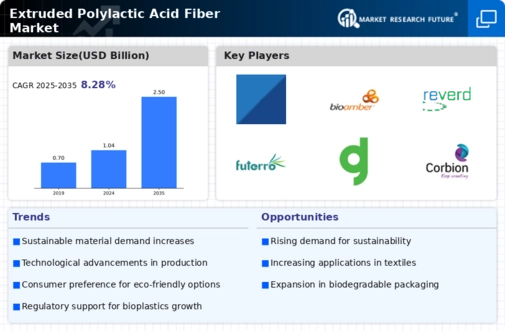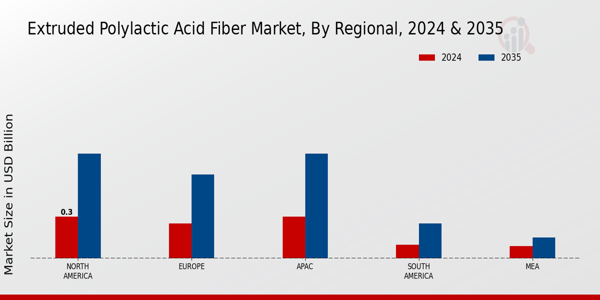Regulatory Support
Regulatory frameworks supporting the use of biodegradable materials are significantly influencing the Extruded Polylactic Acid Fiber Market. Governments across various regions are implementing policies that promote the adoption of sustainable materials, including incentives for manufacturers who utilize PLA fibers. This regulatory support is crucial in driving the market forward, as it not only encourages compliance with environmental standards but also fosters consumer confidence in eco-friendly products. The increasing number of regulations aimed at reducing plastic waste is likely to propel the demand for extruded polylactic acid fibers, as industries seek to align with these mandates. Consequently, the Extruded Polylactic Acid Fiber Market stands to benefit from a favorable regulatory environment that prioritizes sustainability.
Technological Innovations
Technological advancements play a crucial role in shaping the Extruded Polylactic Acid Fiber Market. Innovations in production processes, such as improved extrusion techniques and enhanced polymerization methods, have led to higher quality fibers with better performance characteristics. These advancements not only increase the efficiency of production but also reduce waste and energy consumption, aligning with the industry's sustainability objectives. Furthermore, research into new applications for PLA fibers, including their use in automotive and construction materials, is expanding the market's potential. As a result, the Extruded Polylactic Acid Fiber Market is likely to witness a surge in investment in R&D, fostering a competitive landscape that encourages continuous improvement and innovation.
Sustainability Initiatives
The increasing emphasis on sustainability is a pivotal driver for the Extruded Polylactic Acid Fiber Market. As consumers and manufacturers alike prioritize eco-friendly materials, the demand for polylactic acid (PLA) fibers, derived from renewable resources, is on the rise. This shift is evident in various sectors, including textiles and packaging, where companies are actively seeking alternatives to petroleum-based fibers. The market for PLA fibers is projected to grow significantly, with estimates suggesting a compound annual growth rate (CAGR) of over 20% in the coming years. This growth is largely attributed to the rising awareness of environmental issues and the need for sustainable production practices, which positions the Extruded Polylactic Acid Fiber Market favorably in the context of global sustainability goals.
Growth in End-Use Industries
The expansion of end-use industries such as textiles, packaging, and automotive is driving the growth of the Extruded Polylactic Acid Fiber Market. As these sectors increasingly adopt sustainable materials, the demand for PLA fibers is expected to rise. For instance, the textile industry is projected to witness a significant shift towards biodegradable fibers, with estimates suggesting that the use of PLA could increase by over 15% in the next few years. Additionally, the packaging industry is also leaning towards sustainable solutions, with many companies committing to reducing their plastic footprint. This trend is likely to create new opportunities for the Extruded Polylactic Acid Fiber Market, as manufacturers seek to capitalize on the growing demand for eco-friendly alternatives.
Consumer Demand for Eco-Friendly Products
The rising consumer demand for eco-friendly products is a significant driver for the Extruded Polylactic Acid Fiber Market. As awareness of environmental issues grows, consumers are increasingly seeking products made from sustainable materials. This trend is particularly evident in the fashion and home textiles sectors, where brands are responding by incorporating PLA fibers into their offerings. Market Research Future indicates that a substantial percentage of consumers are willing to pay a premium for sustainable products, which is encouraging manufacturers to invest in the development of extruded polylactic acid fibers. This shift in consumer preferences is likely to continue influencing the market dynamics, as the Extruded Polylactic Acid Fiber Market adapts to meet the evolving demands of environmentally conscious consumers.
























Leave a Comment